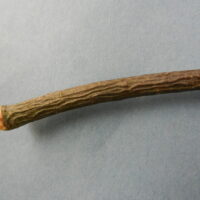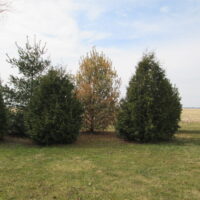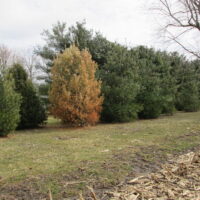 Purdue University - Extension - Forestry and Natural Resources
Purdue University - Extension - Forestry and Natural Resources
Got Nature? Blog
Purdue Landscape Report: I think white pines are beautiful trees, especially at maturity, and they have the added advantage that they are one of the few conifers that don’t try to kill you with their needles. Besides working with the foliage, have you ever had to “rescue” a child who climbed too high in a spike-infested deathtrap of an evergreen? Did you develop the rashes to prove it? Not with a white pine!
My kids haven’t had the chance to climb a mature white pine. Many seem to decline at about 15-20ft. We have been describing this issue as white pine decline, but it isn’t entirely easy to explain. There are a number of factors that influence overall plant health and that can contribute to plant decline, but let’s focus on white pines here. White pine decline is typically attributed to root stress that can be caused by or exacerbated by high soil pH (chemically unavailable nutrients), heavy soil texture (clays), compaction, and excessive soil moisture.
Anything that affects the roots can affect the overall health of the tree, so if the roots are compromised and they cannot uptake water or nutrients, the tree will decline due to lack of nutrients or even lack of water. Needles on an affected tree will turn yellow and eventually brown and fall off prematurely (Figure 1). A symptom of white pine decline includes stems that have shriveled or desiccated bark because roots are not functioning properly and cannot pull in enough water (Figure 2).
Depending on the severity of the root conditions, trees may take several years to decline and die, but with significant root stress, trees will decline faster. I have been seeing a lot of white pine yellowing around West Lafayette and in Indianapolis over the last year and a half and I think the odd environmental extremes have not been helping. Cycling between prolonged drought and torrential downpours lead to stress that can have lasting effects that could take years to recover from, or might be the final nail in the coffin.
There is nothing that can be done to recover from or stop decline once symptoms are observed in white pine. However, taking an approach to actively mitigate stress can help extend the life of white pine trees that are currently healthy. In many cases, one white pine will decline while other trees in the vicinity appear healthy (Fig 3, 4). Removal of symptomatic trees is important because stressed trees often attract bark beetles which can spread to the remaining healthy trees.
Another point: not every tree is going to respond the same way at the same location. Stress factors, such as a poor root system when planted, planting too deeply, or even Phytophthora root rot may have predisposed one tree to decline more than others. Just because one tree goes down doesn’t mean they all will, so keep an eye on the others and try to improve the site conditions where practical.
To view this full article and other Purdue Landscape Report articles, please visit Purdue Landscape Report.
Subscribe and receive the newsletter: Purdue Landscape Report Newsletter.
Resources:
Root Rot in Landscape Plants, The Education Store, Purdue Extension resource center
Dead Man’s Fingers, Purdue Landscape Report
ID That Tree Fall Color: Sugar Maple, Purdue Extension – Forestry and Natural Resources (FNR) YouTube Channel
ID That Tree Fall Color Edition: Black Gum, Purdue Extension – FNR YouTube Channel
An Introduction to Trees of Indiana, The Education Store
Autumn Highlights Tour – South Campus, Purdue Arboretum Explorer
Subscribe, Purdue Extension – FNR YouTube Channel
Tree Defect Identification, The Education Store
Tree Wound and Healing, Got Nature? Blog, Purdue Extension – FNR
Shrubs and Woody Vines of Indiana and the Midwest, The Education Store
Ask an Expert: Tree Selection and Planting, Purdue Extension – FNR YouTube playlist
ID That Tree, Purdue Extension – FNR YouTube playlist
Invasive Species, Playlist, Purdue Extension – FNR YouTube Channel
Report Invasive Species, Purdue Invasive Species
Find an Arborist, International Society of Arboriculture
John Bonkowski, Plant Disease Diagnostician
Departments of Botany & Plant Pathology

Recent Posts
- Purdue Extension 2024 Impact Report
Posted: January 16, 2025 in Forestry, Land Use, Plants, Publication, Wildlife, Woodlands - Opt in to the Deer Management Survey – Wild Bulletin
Posted: January 15, 2025 in Forestry, Urban Forestry, Wildlife - January is a Good Month for Wildlife Tracks – Wild Bulletin
Posted: January 14, 2025 in Urban Forestry, Wildlife - Announcing-New Indiana Woodland Steward Newsletter
Posted: December 19, 2024 in Forestry, Timber Marketing, Wildlife, Woodlands - Red in Winter – What Are Those Red Fruits I See?
Posted: December 18, 2024 in Forestry, Plants, Urban Forestry, Wildlife, Woodlands - ID That Tree: Prickly Ash
Posted: December 16, 2024 in Forestry, Forests and Street Trees, Urban Forestry, Wildlife - Tips on How You Can Recycle Your Christmas Tree
Posted: in Ask the Expert, Christmas Trees, Forestry, Forests and Street Trees, How To, Wildlife - Hardwood Tree Improvement Regeneration Center (HTIRC) Shares Fall Newsletter, Research and Outreach
Posted: December 13, 2024 in Forestry, Land Use, Natural Resource Planning, Woodlands - Ask An Expert: Holidays in the Wild
Posted: December 9, 2024 in Christmas Trees, Forestry, Forests and Street Trees, How To, Plants, Wildlife, Woodlands - Venison Workshops Help Hunters to Safely Process Deer – ANR
Posted: December 4, 2024 in Forestry, Wildlife, Woodlands
Archives
Categories
- Alert
- Aquaculture/Fish
- Aquatic/Aquaculture Resources
- Ask the Expert
- Christmas Trees
- Community Development
- Disease
- Drought
- Forestry
- Forests and Street Trees
- Gardening
- Got Nature for Kids
- Great Lakes
- How To
- Invasive Animal Species
- Invasive Insects
- Invasive Plant Species
- Land Use
- Natural Resource Planning
- Nature of Teaching
- Plants
- Podcasts
- Ponds
- Publication
- Safety
- Spiders
- Timber Marketing
- Uncategorized
- Urban Forestry
- Webinar
- Wildlife
- Wood Products/Manufacturing
- Woodland Management Moment
- Woodlands



